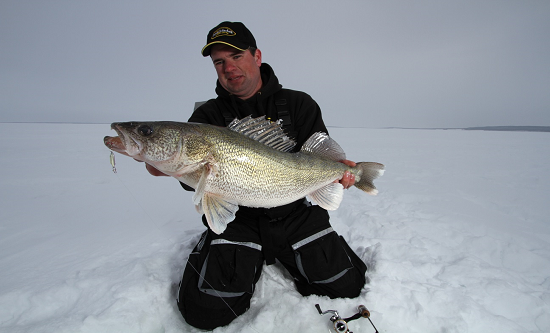Maybe it’s because I’m getting older or maybe it’s because I can cover more ice, but I really enjoy ice fishing on the bare ice—usually sitting over a hole on the back of my snowmobile.
Don’t get me wrong. I still love ice fishing in a shelter and I always have my clients fish from a shelter. It’s just that when I’m actively searching for fish and trying to stay ahead of the bite, I find myself on my sled.
I’ll pop a series of holes around an area that looks good and then hole jump on my sled actively searching for fish. It sounds easy but it’s a lot of work and a lot of stress on the back.
I used to prefer shorter ice fishing rods but I started using longer ones fishing from my sled because my back would get sore leaning over all day long. I switched to longer and longer rods until I really noticed a difference.
I’m not out there with an eight-foot casting rod, but when you are used to 21-inch ice rods, something like the Jason Mitchell 38-inch spinning rod almost feels like it—at first.
That all changes, however, with the first nibble. Longer rods can be very versatile so long as you balance speed and sensitivity. Find a rod that is very sensitive for feeling the bite, even with gloves or cold hands and match it with a fast tip so it doesn’t take much of a reflex to get a solid hook set.
It took a few years to match those elements just right so I’m partial to mine, but it’s really a sweetheart of a rod and easy to balance with a quality spinning reel.
That longer rod allows for more comfort on the ice and translates to having the ability to spend more time searching. Unless it’s one of those fall to winter transitions where it’s open water one week and five inches the next, there’s a lull in between the seasons when the walleye can move.
Generally speaking, those late fall hotspots that produced walleye are still going to hold them during early ice, but there are no guarantees. These are good starting points as are your classic walleye structures like points, humps and hard bottom transition zones.
Once I’m on an area, what I’ll do to search for those fish is drop down a lure that will make some noise and vibration. I’ll tie on a lipless crankbait and let it drop to the bottom. As soon as it hits, I’ll reel up six to nine feet and then repeat.
Every time I do that is like making a separate cast and it’s a great searching technique. If there’s actively feeding walleye in the area, this presentation brings them in—sometimes stacked up three or four at a time.
Once I mark them on my flasher, I’ll entice them to bite with more subtle movements. After I’ve caught the aggressive ones, I’ll slow my approach with subtle lure styles and target the neutral to negative fish in the area.
Whatever the presentation, try fishing with a longer ice fishing rod this winter and notice the difference it makes.

